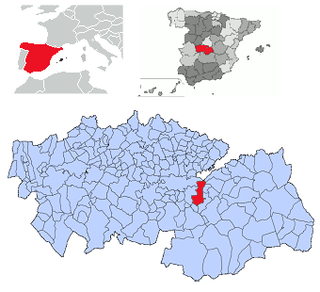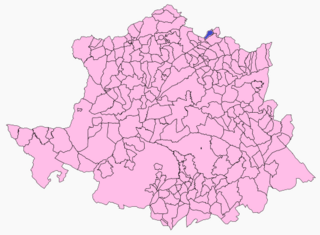
The Peninsular War (1807–1814) was the military conflict fought in the Iberian Peninsula by Spain, Portugal, and the United Kingdom against the invading and occupying forces of the First French Empire during the Napoleonic Wars. In Spain, it is considered to overlap with the Spanish War of Independence.

The Battle of Uclés saw an Imperial French corps led by Marshal Claude Perrin Victor attack a Spanish force under Francisco Javier Venegas. The French easily crushed their outnumbered foes, capturing over half of the Spanish infantry. Uclés is located in the province of Cuenca 15 kilometres (9.3 mi) east of Tarancón and 100 kilometres (62 mi) southeast of Madrid. The action occurred during what is called the Peninsular War in English-speaking countries and the Spanish War of Independence in Spain. The war was part of a larger struggle known as the Napoleonic Wars.

The Battle of Almonacid was fought on 11 August 1809 during the Peninsular War between Sébastiani's IV Corps of the French Peninsular Army, which King Joseph of Spain had withdrawn from the Battle of Talavera to defend Madrid, and the Spanish Army of La Mancha under General Venegas. After the decisive charges of Polish uhlans, the battle resulted in a French victory.

The Battle of Ocaña was fought on 19 November 1809 between French forces under Marshal Soult and King Joseph Bonaparte against the Spanish army under General Aréizaga, which suffered its greatest single defeat in the Peninsular War.

The Battle of Tudela saw an Imperial French army led by Marshal Jean Lannes attack a Spanish army under General Castaños. The battle resulted in the complete victory of the Imperial forces over their adversaries. The combat occurred near Tudela in Navarre, Spain during the Peninsular War, part of a wider conflict known as the Napoleonic Wars.

The Battle of Talavera was fought just outside the town of Talavera de la Reina, Spain some 120 kilometres (75 mi) southwest of Madrid, during the Peninsular War. At Talavera, a British army under Sir Arthur Wellesley combined with a Spanish army under General Cuesta fought in operations against French-occupied Madrid. At nightfall, the French army withdrew a short distance after several of its attacks had been repulsed; the allies, having suffered comparable casualties to the French, made no attempt to pursue.

The Battle of Somosierra took place on 30 November 1808, during the Peninsular War, when a combined Franco-Spanish-Polish force under the direct command of Napoleon Bonaparte forced a passage through a Spanish Division stationed at the Sierra de Guadarrama, which shielded Madrid from direct French attack. At the Somosierra mountain pass, 60 miles (97 km) north of Madrid, a heavily outnumbered Spanish detachment of regulars, volunteers and artillery under Benito de San Juan aimed to block Napoleon's advance on the Spanish capital. Napoleon overwhelmed the Spanish positions in a combined arms attack, sending the Polish Chevau-légers of the Imperial Guard at the Spanish guns while French infantry advanced up the slopes. The victory removed the last obstacle barring the road to Madrid, which fell several days later.

The Battle of Alcañiz resulted in the defeat of Major-General Louis Gabriel Suchet's French army on 23 May 1809 by a Spanish force under General Joaquín Blake y Joyes.

The Battle of Tamames was lost by part of Marshal Michel Ney's French army under General of Division Jean Marchand in the Peninsular War. The French, advancing out of Salamanca, were met and defeated in battle by a Spanish army on 18 October 1809.

In the Peninsular War, the Battle of Medellín was fought on 28 March 1809 and resulted in a victory of the French under Marshal Victor against the Spanish under General Don Gregorio Garcia de la Cuesta. The battle marked the first major effort by the French to occupy Southern Spain, a feat mostly completed with the victory at the Battle of Ocana later in the year.

The second siege of Zaragoza was the French capture of the Spanish city of Zaragoza during the Peninsular War. It was particularly noted for its brutality. The city was heavily outnumbered against the French. However, the desperate resistance put up by the Army of Reserve and its civilian allies had been heroic: a great part of the city lay in ruins, the garrison had suffered 24,000 deaths being augmented by 30,000 civilians dead.

The Battle of Belchite on 18 June 1809 saw a Franco-Polish corps led by Louis Gabriel Suchet fight a small Spanish army under Joaquín Blake y Joyes. Suchet's force won the battle when a lucky hit detonated a large part of the Spanish ammunition supply. The ensuing blast provoked Blake's soldiers into a panicky flight from the battlefield. The action was fought during the Peninsular War, part of the Napoleonic Wars. Belchite is located 40 kilometres (25 mi) southeast of Zaragoza.

In the First Battle of Porto the French under Marshal Soult defeated the Portuguese, under General Parreiras, outside the city of Porto during the Peninsular War. Soult followed up his success by storming the city.

In the Battle of Alba de Tormes on 28 November 1809, an Imperial French corps commanded by François Étienne de Kellermann attacked a Spanish army led by Diego de Cañas y Portocarrero, Duke del Parque. Finding the Spanish army in the midst of crossing the Tormes River, Kellermann did not wait for his infantry under Jean Gabriel Marchand to arrive, but led the French cavalry in a series of charges that routed the Spanish units on the near bank with heavy losses. Del Parque's army was forced to take refuge in the mountains that winter. Alba de Tormes is 21 kilometres (13 mi) southeast of Salamanca, Spain. The action occurred during the Peninsular War, part of the Napoleonic Wars.

The Battle of Los Yébenes was the clash of the Regiment of Polish Lancers of the Legion of the Vistula with multiple regiments of Spanish cavalry, near the Spanish village of Los Yébenes. The heavily outnumbered Polish regiment, led by Colonel Jan Konopka, was attacked by surprise and almost defeated by the larger Spanish force.

The siege of Astorga was an attempt by French forces to capture Astorga, Spain in a campaign of the Peninsular War. Astorga was located on the flank of the French invasion of Spain and Portugal, and was meant to be used as a headquarters during the campaign. For several weeks no attack took place, as neither side had artillery enough to fight well. Shortly after the French guns arrived, however, a hole was made in the wall and the city fell shortly thereafter. The French overpowered the Spanish garrison inside and took the city on 22 April 1810.

The Battle of Carpio or Battle of El Carpio took place at El Carpio, near Medina del Campo, Valladolid, on 23 November 1809, between a Spanish force of 19,000 men commanded by the Lieutenant-General Diego de Cañas y Portocarrero, Duke del Parque and a French force of 10,000 regulars and 1,700 cavalry under the General François Étienne de Kellermann during the Peninsular War. The French forces were defeated and forced to leave the town. In this struggle, died two distinguished Spanish leaders, Salvador de Molina and Colonel Juan Drimgold.

The Battle of Alcántara saw an Imperial French division led by Marshal Claude Perrin Victor attack a Portuguese detachment under Colonel William Mayne. After a three hours skirmish, the French stormed across the Alcántara Bridge and forced the Portuguese to retreat. The clash happened during the Peninsular War, part of the Napoleonic Wars. Alcántara, Spain is situated on the Tagus river near the Portuguese border, 285 kilometres (177 mi) west-southwest of Madrid.

The Battle of Arzobispo on 8 August 1809 saw two Imperial French corps commanded by Marshal Jean-de-Dieu Soult launch an assault crossing of the Tagus River against a Spanish force under José María de la Cueva, 14th Duke of Alburquerque. Alburquerque's troops rapidly retreated after suffering disproportionate losses, including 30 artillery pieces. El Puente del Arzobispo is located 36 kilometres (22 mi) southwest of Talavera de la Reina, Spain. The action occurred during the Peninsular War, part of a larger conflict known as the Napoleonic Wars.

The Battle of Puerto de Baños saw a Portuguese-Spanish column led by Robert Wilson attempt to defend a mountain pass against Marshal Michel Ney's VI Corps. After a nine-hour combat, Wilson's force broke up and scattered into the mountains. Baños de Montemayor is located about 45 kilometres (28 mi) northeast of Plasencia, Spain. The clash occurred during the Peninsular War, part of a larger struggle known as the Napoleonic Wars.

















